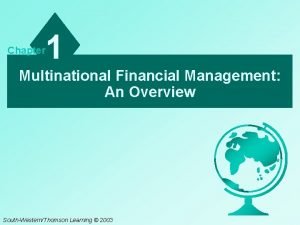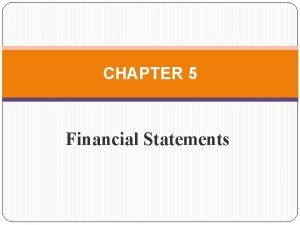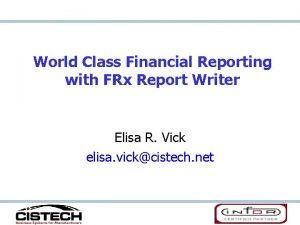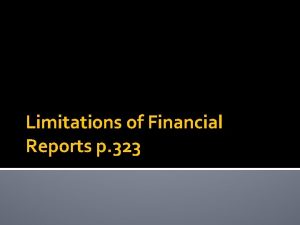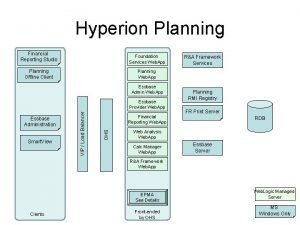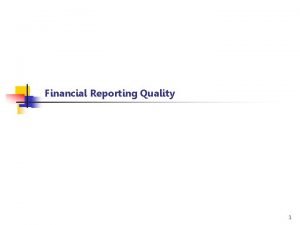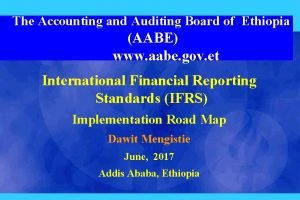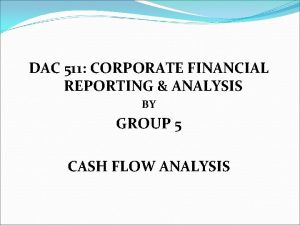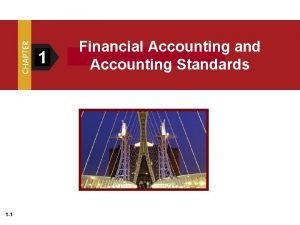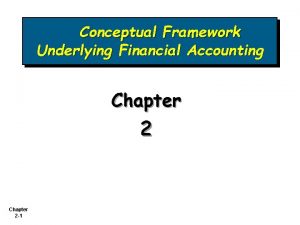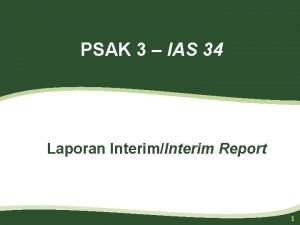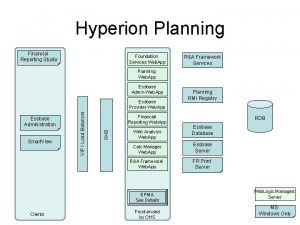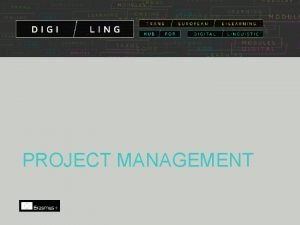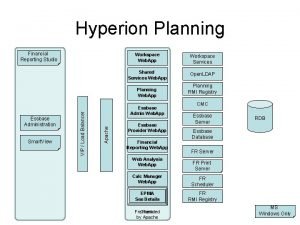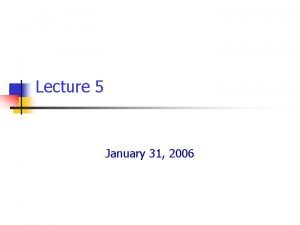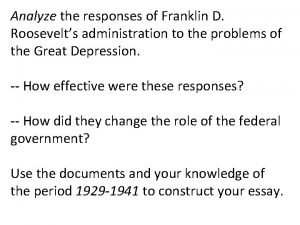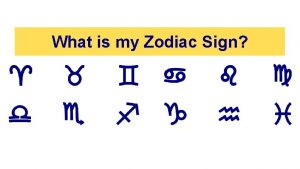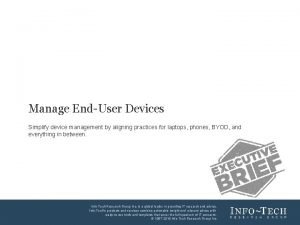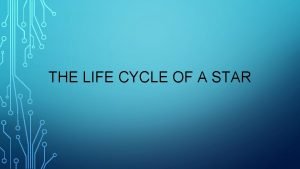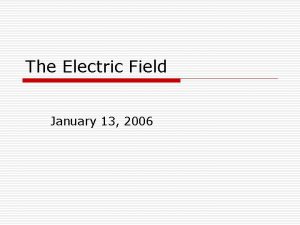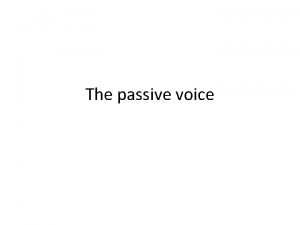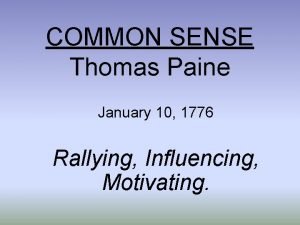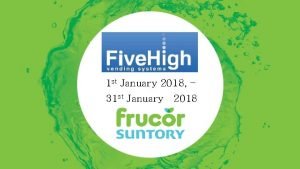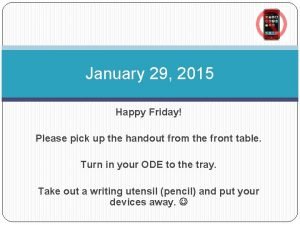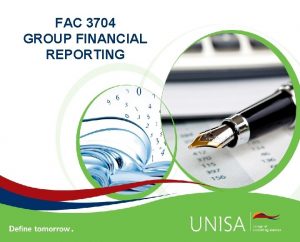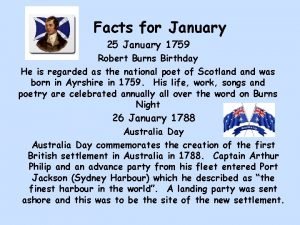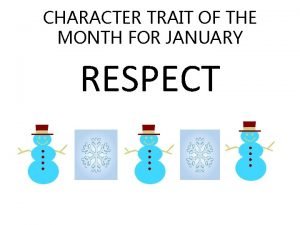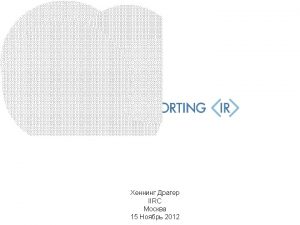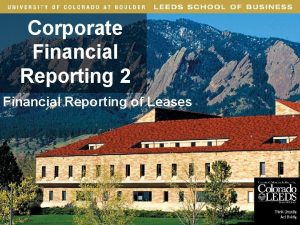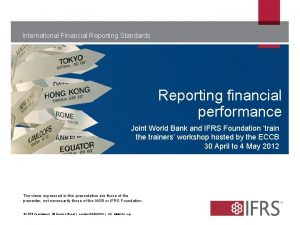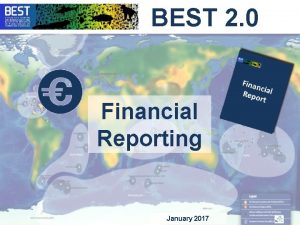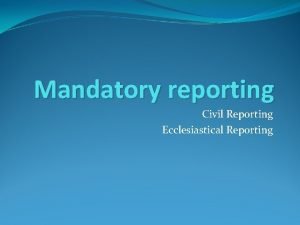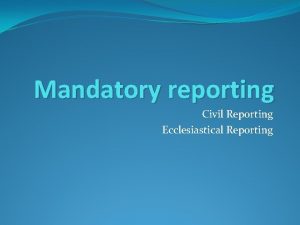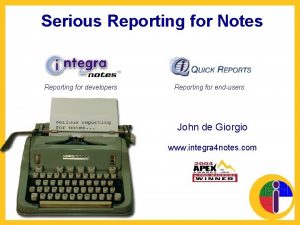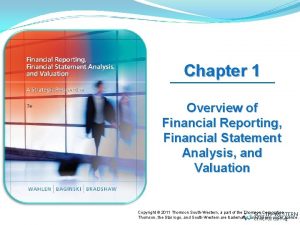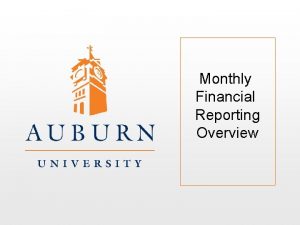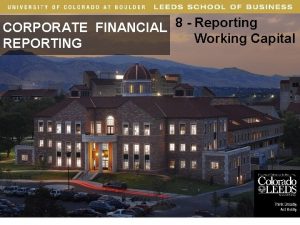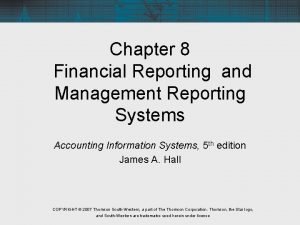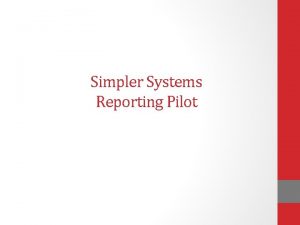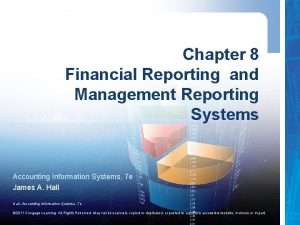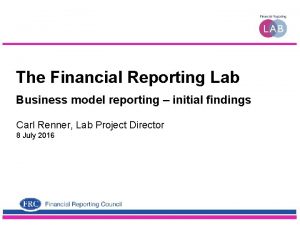Financial Reporting Overview January 9 2019 1232020 1


































































- Slides: 66

Financial Reporting Overview January 9, 2019 12/3/2020 1

Financial Review Committee (FRC) • Composed of Board Members • Responsible for reviewing and approving the financial information submitted • Referrals to enforcement panel for enforcement action 12/3/2020 2

Who Needs to Submit Financial Statements? • Applicants for a License • Applicants for Renewal of License – initially 1 year / then every 2 years • Applicants for Scholarship • Applicants for Change of Ownership • Schools on Quarterly Reporting NOTE: This Session does not cover Annual Statistical Survey reporting 12/3/2020 3

Who Submits Quarterly Report? • New Schools • Schools that have changed ownership • Schools with financial concerns – Identified in renewal – Notification from accreditor or USDE – Legal action 12/3/2020 4

Quarterly Reporting • Is a monitoring process • Is not a sanction or punishment 12/3/2020 5

Types of Financial Reports • New Schools Ø Pro-forma Projections Ø PDE-2006 Ø Audited statement • License Renewal/ Scholarship/ Change of Ownership Ø PDE-2006 (Annual) • Quarterly Reporting Ø PDE-2006 (Qtrly) 12/3/2020 6

Quarterly Reporting • New Schools and Change of Ownership are automatically placed on quarterly reporting 12/3/2020 7

PDE-2006 • A guide for the FRC to assess the financial strength and solvency of a school 12/3/2020 8

Quick View of Instructions 12/3/2020 9

PDE-2006 • Measures the current condition and ability to operate in the future through: – Income Statement (page 1) – Revenue and Expenses – Balance Sheet (page 2) – Assets, Liabilities and Stockholder’s Equity – Disclosure Information (page 3) – Methodologies, Terms of Significant Notes, Parent Company Information, Pending Regulatory/Legal Issues and Explanations – Key Indicators (page 4) – Individual program information 12/3/2020 10

Income Statement 12/3/2020 11

Balance Sheet 12/3/2020 12

Disclosure Section 12/3/2020 13

Key Indicators 12/3/2020 14

PDE-2006 – General Guidelines • All financial information must conform with Generally Accepted Accounting Principles (GAAP) – The common set of accounting principles, standards and procedures that companies use to compile their financial statements. GAAP are a combination of authoritative standards (set by policy boards) and simply the commonly accepted ways of recording and reporting accounting information. – Imposed on companies so that investors have a minimum level of consistency in the financial statements they use when analyzing companies for investment purposes. GAAP cover such things as revenue recognition, balance sheet item classification and outstanding share measurements. – Still Room for interpretation and different methodologies within GAAP. 12/3/2020 15

PDE-2006 – Accrual Accounting • Key concept of GAAP is Accrual Accounting – An accounting method that measures the performance and position of a company by recognizing economic events regardless of when cash transactions occur. The general idea is that economic events are recognized by matching revenues to expenses (the matching principle) at the time in which the transaction occurs rather than when payment is made (or received). This method allows the current cash inflows / outflows to be combined with future expected cash inflows / outflows to give a more accurate picture of a company's current financial condition. 12/3/2020 16

Accrual Accounting – Revenue Example Revenue A student starts a six month program on July 1. He/she pays his/her full tuition on October 1 st. Recognized when earned Cash Recognized when collected Revenue – recognize 1/6 th of the tuition each month for 6 months Revenue – recognize the full tuition when paid in October Accrual 12/3/2020 17

Accrual Accounting – Expense Example Expense A school pays their property insurance every year on April 1 st. Insurance covers from May 1 – April 30 of the following year. Accrual Cash Recognized when used Recognized when paid Expense – recognize 1/12 th of the costs of the insurance each month from May through April Expense – recognize the full cost of the insurance when paid in April 12/3/2020 18

PDE-2006 – Balance Sheet • Three Sections: – Assets – what a company owns – Liabilities – what a company owes – Stockholder’s Equity – the amount invested by shareholder(s) • Measurement of a company at a particular point in time (e. g. June 30) • Called a Balance Sheet because the 2 sides must balance (Assets = Liabilities + Stockholder’s Equity) • Balances are “permanent” 12/3/2020 19

PDE-2006 – Assets • Split into Current and Long-Term – Current Assets – can be converted to cash or consumed < 1 year • Cash (on hand restricted) • Accounts Receivable (student and other) • Inventory – Non-Current Assets - > 1 year • Property and Equipment • Prepaid Expenses • Goodwill 12/3/2020 20

PDE-2006 – Liabilities • Split into Current and Long-Term – Current Liabilities – need to be settled / paid < 1 year • • Accounts Payable / Notes Payable Tuition Refunds Payable Current Portion of Long-Term Debt Unearned Tuition – Long-Term Liabilities - > 1 year • Notes or Bonds Payable • Due To / From Parent 12/3/2020 21

PDE-2006 – Stockholder’s Equity (also called net worth or owner’s equity) • Equity represents the capitalization and the retained earnings of the organization – Capitalization – capital contributed to an organization (either through stock or direct paid-in contributions) – Retained Earning – the amount of net income that an entity retains/re-invests back into its operations 12/3/2020 22

PDE-2006 – Capitalization • Ways to Capitalize – Cash investment – either through the purchase of stocks or direct capital contribution (Other Equity) – Contribution of equipment, building, or other asset • Note – Cash or Contribution of an Asset represents a capital investment made in the organization to purchase assets, pay expenses, or use in day to day operations of the business. Capital is not expected to be paid back. – Issuance of a Note Payable • Note – Notes payable are recorded as a liability and are paid back over time and place an additional burden on the organization * Terms of the note payable must be disclosed on page 3 of the PDE 2006 (example: 5 year, 8% note payable to Bob Smith, proprietor. Note due on demand. ) 12/3/2020 23

PDE-2006 – Retained Earnings • Retained Earnings: Earnings (Loss) for Year - reflects the net income / (loss) from the Income Statement • Dividends – the payout of any earnings to shareholders • Retained Earnings: Ending Balance is closed out to the Beginning Balance each year 12/3/2020 24

PDE-2006 – Retained Earnings • Key Aspects – Balance Sheet must balance – Retained Earnings for Current Year Must = Net Income for Current Year 12/3/2020 25

Error Messages 12/3/2020 26

PDE-2006 – Balance Sheet • Evaluation criteria – Current Ratio > 1: 1 – Cash, Total Assets, Unearned Tuition, Retained Earnings and Total Stockholder’s Equity must be > $0 or provide explanation – Capitalization – How well and for how long can an entity sustain operations 12/3/2020 27

PDE-2006 – Income Statement • Represents the financial performance resulting from the operations of the entity • Two Components – Revenue – Expense • Measurement of a company’s performance over a period of time – Quarter Ending – a three month period – Year to Date – range from 3 months to 12 months depending upon year end date • Balances are closed out every year 12/3/2020 28

PDE-2006 – Income Statement • PDE-2006 Income Statement is split into 2 sections: – Educational Income – tuition revenue less expenses incurred in operating (or running) the school – Other Income and Expense – revenue and expenses recognized from non-school / operating activities (clinic revenues, contract training, etc. ) 12/3/2020 29

Tuition and Other Income 12/3/2020 30

PDE-2006 – Revenue • Educational Revenue = Tuition • In order to be compliant with GAAP, Revenue must be recognized when earned, not collected or billed (revenue recognition) • Deduct any tuition refunds recognized in current period (regardless of who it is owed to or when it will be paid) • Deduct cost of books and/or supplies given to students as part of the program 12/3/2020 31

Tuition Revenue Example – School A starts 10 students on January 1. They charge $2, 000 tuition for the 52 week program. There were no other starts in the year and half the students paid their full tuition by the end of the 1 st quarter. The school’s financial statements would reflect the following on March 31: Balance Sheet Cash Asset $10, 000 A/R – Student Asset $10, 000 Unearned Tuition Liability $15, 000 Gross Tuition 12/3/2020 Income Statement Revenue $5, 000 32

Explanation of Example Why did we Recognize $5, 000 of Tuition Revenue? 10 students * $2, 000 = $20, 000 (total revenue) $20, 000 / 12 months (for the 52 week program) = $1, 666. 67 (revenue earned per month) $1, 666. 67 * 3 months (from January 1 – March 31) = $5, 000 12/3/2020 33

PDE-2006 – Expenses • Recognize all expenses incurred in operating the school: - Including but not limited to Salaries and Benefits, Classroom Supplies, Rent, Mortgage, Depreciation, Utilities, Bad Debt, Advertising and Taxes • Include school related activity only – Do not include consolidated results – Do include school’s portion of shared costs or management fees • Expenses must be on accrual basis 12/3/2020 34

Accrued Expense Example – School B pays their utility bill each month. The utility bill, which covered the period February 15 – March 14, was $560. The school’s financial statements would reflect the following on March 31: Cash A/P Utilities 12/3/2020 Balance Sheet Asset Liability ($560) $340 Income Statement Expense $900 35

Explanation of Example • Why did we accrue $340? • How it was calculated – The $560 bill was for a 28 day period (February 15 - March 14). That works out to $20/day ($560/28). There are 17 days remaining in the month (March 15 - March 31). 17 days * $20 = $340. • The $340 represents that amount of utilities used by the organization but not yet paid. The amount will be paid with the next bill (around April 15). • Any expense that is likely to occur and can be estimated, must be accrued. 12/3/2020 36

Accrued Expense Example #2 Example – School C offers a $2, 400 bonus to its school director is she achieves her targets. It is reasonable to expect that the director will earn her bonus. The bonus is paid out January of next year (once the results are final). The school’s financial statements would reflect the following at the close of each month: A/P Administrative Expense 12/3/2020 Balance Sheet Liability $200 Income Statement Expense $200 37

Disclosure Information • Valuation Methodologies – Inventory, Depreciation, Revenue • • • Default Rate Terms of Notes Payable / Receivable Parent Company Information Adverse Findings / Legal Action Explanations for Negative / $0 Balances 12/3/2020 38

Disclosure Section 12/3/2020 39

Key Indicators • Measures the performance of each program – – – Accreditation – Yes or No Ending Student Population Students on Temporary Leave Attrition Rate Graduation Rate Placement Rate • Instructions on Key Indicator measurements are meant to assist the schools. Use your accrediting / regulatory body calculations where possible 12/3/2020 40

Key Indicators 12/3/2020 41

Key Indicators • Attrition Rate – measures the % of students who permanently withdraw from a program 40 students withdraw during the year (120 students beginning+80 starts+10 re-entries) = 19% 12/3/2020 42

Key Indicators • Placement Rate – measures the proportion of students who receive full time employment in their intended field compared to the number of graduates 70 students employed 90 students eligible for employment = 78% 12/3/2020 43

Summary of Financial Reports PDE-2006 Actual results only Balance Sheet Income Statement Disclosure Section Key Indicators Quarterly/Annual Reports 12/3/2020 Pro-Forma Forecast (estimates) Income Statement only Filed only with a new school application 44

Entry of Name, Address and Date Licensed 12/3/2020 45

Entry of Methods Used – Page 3 12/3/2020 46

Unearned Tuition 12/3/2020 47

Parent Company Information 12/3/2020 48

Key Indicators 12/3/2020 49

Checklist for PDE-2006 • Did you obtain the current, most up-to-date form from the web site? • Are year-to-date and quarter dates correct? • Does quarter end date on balance sheet match income statement? • Did you enter all information, including school name, address, date licensed, etc. ? 12/3/2020 50

Checklist Continued • Does the balance sheet balance? • Does income = retained earnings? • Are entries included for methods used to determine inventory, depreciation, and unearned tuition? 12/3/2020 51

Checklist Continued • Are entries for methodologies accounting terms? – not numbers or n/a, etc. • Did you enter your business type? i. e. LLC, C-Corp, S-Corp, etc. Not “school” • Did you include details on notes payable and notes receivable? Amount, Terms, Interest, etc. • Did you include parent company information? 12/3/2020 52

Checklist Continued • Did you include your method of accounting for unearned tuition. Is it appropriate? Not “none” or n/a. Not a restatement of refund policy. 12/3/2020 53

Checklist Continued • Did you complete Key Indicators section? • Did you answer accreditation question accurately? Note accreditation is not the same as licensure. • Did you include all programs, even if you are not currently enrolling? 12/3/2020 54

Lines with * • Are there any zeroes in lines with *? If so, an explanation is required on page 3. 12/3/2020 55

Check List • Did you put the name of the responsible person in the signature block? – Signature not possible on electronic form, but name of responsible person required. 12/3/2020 56

Name in Lieu of Signature 12/3/2020 57

Lines with * 12/3/2020 58

Explanations of Lines with * 12/3/2020 59

Sharepoint Submission of Financials Includes such documents as: • Financials for ownership changes • Quarterly reports • Financials for scholarship applications 12/3/2020 60

Sharepoint Screen 12/3/2020 61

Upload Document – Click Browse 12/3/2020 62

Choose Type of Submission 12/3/2020 63

Closing Thoughts • Inaccurate Reporting – Results in delayed approvals – Results in follow-up questions – May result in requirement of audited reports – May result in referral for enforcement action • Late Reports – Late fees of $50 per day up to $500 12/3/2020 64

Questions • Division of Higher and Career Education • (717) 783 -8228 12/3/2020 65

Contact/Mission For more information on financial reporting please visit PDE’s website at www. education. pa. gov/PLS The mission of the Department of Education is to ensure that every learner has access to a world-class education system that academically prepares children and adults to succeed as productive citizens. Further, the Department seeks to establish a culture that is committed to improving opportunities throughout the commonwealth by ensuring that technical support, resources, and optimal learning environments are available for all students, whether children or adults. 12/3/2020 66
 1232020
1232020 May 2019 ib grade boundaries
May 2019 ib grade boundaries Pama reporting 2019
Pama reporting 2019 Chapter 1 an overview of financial management
Chapter 1 an overview of financial management Overview of financial management
Overview of financial management Chapter 1 overview of financial statement analysis
Chapter 1 overview of financial statement analysis Chapter 2 an overview of the financial system
Chapter 2 an overview of the financial system Overview of financial management
Overview of financial management Multinational financial management meaning
Multinational financial management meaning Ethiopian government accounting
Ethiopian government accounting Frx report designer
Frx report designer Normalised earnings limitations
Normalised earnings limitations Hyperion foundation services
Hyperion foundation services Limitations of financial reporting
Limitations of financial reporting Cbd financial reporting framework
Cbd financial reporting framework Aabe ethiopia
Aabe ethiopia Corporate financial reporting and analysis
Corporate financial reporting and analysis Financial accounting standards
Financial accounting standards Conceptual framework levels
Conceptual framework levels Third level of conceptual framework
Third level of conceptual framework Ias 34 interim financial reporting
Ias 34 interim financial reporting Financial statement purpose
Financial statement purpose Chapter 2 conceptual framework
Chapter 2 conceptual framework What is financial reporting studio?
What is financial reporting studio? Project management financial reporting
Project management financial reporting Financial reporting studio
Financial reporting studio International financial reporting standards 9
International financial reporting standards 9 Financial and non financial methods of motivation
Financial and non financial methods of motivation January 19 1809
January 19 1809 An asset was purchased for $120 000 on january 1
An asset was purchased for $120 000 on january 1 Paula hurlock birthday
Paula hurlock birthday February and march season
February and march season 15 janvier 1929
15 janvier 1929 Mozart who was born on january
Mozart who was born on january Jack hartmann january
Jack hartmann january January 31 2006
January 31 2006 Lipsume
Lipsume William lloyd garrison the hand of improvidence
William lloyd garrison the hand of improvidence What is the theme for the month of january
What is the theme for the month of january January 15, 1929
January 15, 1929 June 2012 chemistry regents answers
June 2012 chemistry regents answers Mozart birth
Mozart birth When was poe born
When was poe born Letter to senator robert wagner 1934
Letter to senator robert wagner 1934 January 27, 1756
January 27, 1756 Zodiac for january 20
Zodiac for january 20 January february march
January february march 15 janvier 1929
15 janvier 1929 February march april may june july
February march april may june july Manage end user devices
Manage end user devices 1995 january 23 nasa
1995 january 23 nasa Polytechnic hardware store
Polytechnic hardware store January starts the year poem risa jordan
January starts the year poem risa jordan 25 january scotland
25 january scotland January 13 2006 calendar
January 13 2006 calendar Many people begin new projects in january
Many people begin new projects in january January 10th 1776
January 10th 1776 1st january 2018
1st january 2018 He was born in salzburg austria on january 27 1756
He was born in salzburg austria on january 27 1756 Chemistry regents january 2018 answers
Chemistry regents january 2018 answers January 29 2015
January 29 2015 Fac3704
Fac3704 January comes before february
January comes before february January 24th 1848
January 24th 1848 His birth date was on 25 january 1759
His birth date was on 25 january 1759 Respect character trait
Respect character trait 4 january 1643
4 january 1643








